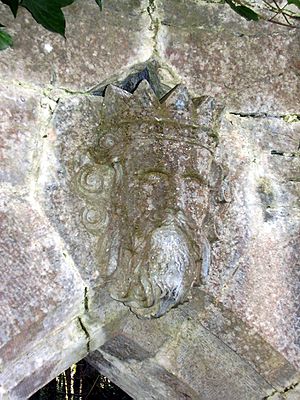Ruaidrí Ua Conchobair facts for kids
Quick facts for kids Ruaidrí Ua Conchobair |
|
|---|---|

Stone carving, Cong Abbey
|
|
| High King of Ireland | |
| Reign | 1166 – 1198 |
| Predecessor | Muirchertach Mac Lochlainn |
| Successor | Brian Ua Néill (Disputed) |
| Born | c. 1116 Kingdom of Connacht |
| Died | 2 December 1198 |
| Burial | Clonmacnois, County Offaly |
| Spouse | Six (including Dubhchobhlaigh Ní Ruairc) |
| Dynasty | O'Conor |
| Father | Toirdelbach Ua Conchobair |
| Mother | Caillech De Ní hEidhin |
| Religion | Catholic |
Ruaidrí Ua Conchobair (also known as Rory O'Conor) was a powerful Irish leader. He was the King of Connacht from 1156 to 1186. He also became the High King of Ireland from 1166 to 1198. Ruaidrí was the last High King of Ireland before the Normans arrived.
Ruaidrí was one of over twenty sons of King Tairrdelbach Ua Conchobair. His mother was Caillech De Ní hEidhin.
Contents
Ruaidrí Ua Conchobair: Ireland's Last High King
Early Life and Becoming King
Ruaidrí was not his father's first choice to be king. His brother Conchobar was expected to take over. In 1136, Ruaidrí and his brother Aedh rebelled against their father. Aedh was blinded, but Ruaidrí was protected by the Archbishop of Connacht.
In 1143, Ruaidrí rebelled again. He was arrested by his brother Conchobar. After a year in prison, he was released. This happened after Conchobar was killed later that year.
Ruaidrí then worked to become his father's chosen heir. He led successful raids against other leaders. He also captured and killed a rival, Domnall Ua Conchobar. In 1151, he raided Thomond, showing his strength.
The Story of Dearbhforgaill
In 1152, a woman named Dearbhforgaill left her husband, Tighearnán Ua Ruairc. She went with Dermot MacMurrough, the King of Leinster. This event was written about much later. Some historians believe she chose to leave her husband. This event later played a part in the Norman invasion.
Becoming King of Connacht
Ruaidrí's father, Tairrdelbach, died in 1156. Ruaidrí became King of Connacht without anyone opposing him. To keep his power, he arrested three of his brothers. One of them, Brian Breifneach, was blinded.
After Tairrdelbach's death, Muirchertach Mac Lochlainn became High King. He started conflicts in other parts of Ireland. Ruaidrí prepared for attacks from Mac Lochlainn. He positioned his fleet on the River Shannon.
Mac Lochlainn tried to control more areas. He took hostages and forced kings to flee to Connacht. Ruaidrí responded by attacking Mac Lochlainn's lands. He also went into Munster and changed Mac Lochlainn's political plans there.
High King of Ireland
In 1166, Muirchertach Mac Lochlainn died. Ruaidrí then went to Dublin and was made High King of Ireland. He was the first High King to be chosen without major opposition. He held a special event called Oneach Tailltann. This was a tradition for High Kings.
One of Ruaidrí's first actions was to invade Leinster. He expelled its king, Dermot MacMorrough. Ruaidrí then received hostages from other Irish leaders. This showed they accepted him as High King. His main power was still in his home province of Connacht.
Facing the Norman Invasion
Ruaidrí's strong position changed with the Norman invasion of Ireland. The Normans came to help Dermot MacMorrough get his throne back. Ruaidrí fought against the Normans and their Irish allies. He lost control of much of Leinster. He also lost the cities of Waterford and Wexford.
Ruaidrí was able to unite many Irish military forces. This had not happened since the time of Brian Boru. He led a huge army of sixty thousand men. He also had a fleet of 30 ships. Their goal was to take back land from the Normans. They especially wanted to retake Dublin.
Ruaidrí's forces pushed the Normans out of Kildare and Meath. They burned Norman castles at Trim and Kells. This led to the siege of Dublin in 1171. However, Ruaidrí's army was defeated. The Normans attacked their camp while they were resting. After this loss, Ruaidrí's army pulled back.
Despite the defeat at Dublin, Ruaidrí kept control of the Midlands. The Normans conquered northern and southern Leinster. They also took parts of eastern Munster. But this was mostly the limit of their expansion during Ruaidrí's reign. Ruaidrí's forces defeated a Norman expedition into Munster. Northern Irish kings also fought off attacks and raided Norman areas.
Later Years and Legacy
In 1175, Ruaidrí signed the Treaty of Windsor with King Henry II of England. However, King Henry could not control his Norman barons. They kept conquering Irish land. Ruaidrí also could not control the smaller Irish kings. This led to more conflict for centuries.
Ruaidrí gave up his kingship in 1183. He returned to rule briefly two more times after that. Ruaidrí died in 1198. He was the last Gaelic High King of Ireland.
His Children and Descendants
Ruaidrí had many children. The records list thirteen children. However, his direct male descendants did not continue to hold the kingship of Connacht. The last of his direct male line mentioned in records died in 1242.
All later kings of Connacht came from Ruaidrí's younger brother, Cathal Crobhdearg Ua Conchobair. Only two of Ruaidrí's descendants later tried to claim the Irish High Kingship. These were Brian Ua Néill (died 1260) and Edward Bruce (died 1318).
See also
 In Spanish: Ruaidrí Ua Conchobair para niños
In Spanish: Ruaidrí Ua Conchobair para niños

